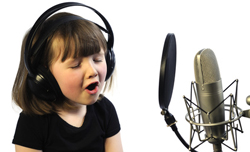 I am a voice-over actor as well as a musician, so Home Brew Audio provides articles and tutorials on both types of recording. Vocal recording for voice-over actors is mostly the same as for musicians but for one thing – there is no music mixed in behind a voice-over recording (at least not usually, and not for long it there is some). So it is that much more important to get the cleanest (least noise) and clearest (best audio quality) recording possible.
I am a voice-over actor as well as a musician, so Home Brew Audio provides articles and tutorials on both types of recording. Vocal recording for voice-over actors is mostly the same as for musicians but for one thing – there is no music mixed in behind a voice-over recording (at least not usually, and not for long it there is some). So it is that much more important to get the cleanest (least noise) and clearest (best audio quality) recording possible.
I found an article on Audiolinks.com yesterday offering 3 microphone tips for voice-over actors. They are good tips, but I wanted to add some things to that post.
The author’s second tip speaks of creating unique tones. He mentions getting closer to the mic to create a deeper sound. This is called “the proximity effect,” and will only work if the mic has a cardioid pick-up (sometimes called “polar”) pattern. Most mics will have that pattern by default, but if you use a multi-pattern mic (my main mic, the Rode NT2-A is one such), you can choose cardioid, figure-8 or omni-directional pickup patterns. So you should be aware that if you are using, say, the “omni” setting, you will not get the proximity effect by moving closer to the mic. By the way, for a review of pickup patterns, see may article Directional and Omnidirectional Microphones – What Are They Good For?
I agree with the “3-tips” tips in the article. But I thought I’d add something about types of microphones. All other things being equal, a voice-over actor should be using a large diaphragm condenser microphone LDC). They typically sound much better than dynamic mics for a variety of reasons (see our article What Are The Different Types of Microphones?). There are some dynamic mics that work well for voice-over, such as the ElectroVoice RE20, which is a very popular broadcast mic. But these are usually more expensive than most LDCs that are excellent for voice-over. The RE20, for example, costs $450.
I did a review of the Audio-Technica AT2035, complete with audio examples, if you’d like to hear what a decent voice-over mic costing $149 sounds like. That post is here: Review of the Audio-Technica AT2035 Microphone.
So enough of my stump-speech. The 3-tips article is here: https://www.audiolinks.com/blog/4-microphone-tips-for-voice-over-actors/
Cheers!
Hey, I took a look at your link to the 3 tip article. I found it really helpful, especially tip number 3; remembering your audience – this is a crucial point to remember! Thanks so much
You’re welcome, Sam!
Ken